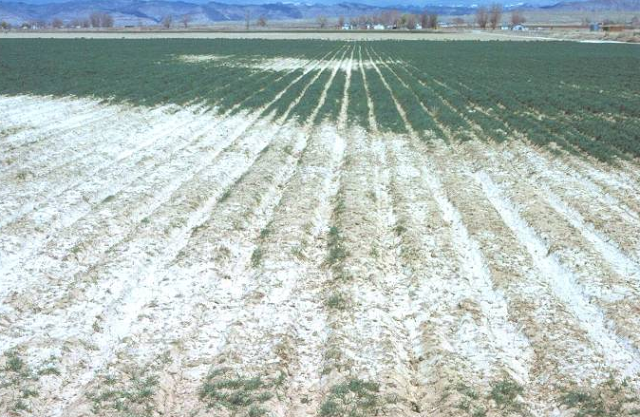 |
| How to manage Saline Soils |
How to manage Saline Soils
Saline Soil
Saline soil may be defined as the soil having a conductivity of the saturation Extract greater than 4mmhos/cm, exchangeable Sodium Percentage (ESP) less than 15 and PH less than 8.5.
When the soil contains excess of Sodium salts and clay complex still contains exchangeable Calcium, the soil is known as saline soil or White alkali or Brown alkali soil. The process of salts leading to formation of soil is known as salinization.
Characteristics of Saline Soil
In dry season, a layer of white crush is formed over the surface. So, it is called white alkali.
ESP is very low, being less than 15% of total cation exchange capacity.
PH varies between 7.5 to 8.5.
Total soluble salt content is more than 0.1%. It is high enough to interfere with normal growth of most plant species.
Electrical conductivity(EC) of solution extract (saturated) is 4 or more than 4 mmhos/cm.
Saline soil remain in flocculated condition granulated. It is permeable to water and soil.
Soluble salt like sulphate, chloride and carbonates of sodium, magnesium, calcium are present.
Management of Saline Soil
A. Mechanical method
1. Flooding and leaching down of soluble salts
The leaching can be down by first ponding water on land and allowing it to stand, therefore a week. Most of the soluble salt would leach down below the root zone. After a week, standing water is escape. such 23 treatment are given to reclaim highly saline soil. Gypsum is added to flood water when the soluble salt are low in calcium to check development of alkalinity.
2. Scraping of surface soil-
When soluble salt accumulate on the soil surface, scraping help to remove salts. This is a tempority cure.
B. Cultural Method
1.Providing proper drainage If the soil is not free draining, artificial drains are open to wash out the salts.
2. Use of salt free irrigation water salt free irrigation water should be used.
3. Proper use of irrigation water-
If the amount of water in the soil is decrease the concentration of salt in the soil solution is increase. Thus moisture should be kept at optimum field capacity.
4. Use of acidic fertilizer Acidic nature of fertilizer should be used.
5. Use of organic manures
Organic manure have high water holding capacity. When sufficient amount
of organic manure are added the water holding capacity of soil are increases. As a result, the conductivity of the soil solution decreases.
6. Ploughing and levelling of land
Ploughing and levelling increases the infiltration and percolation rate of the land. Thus salts leach down to the lower level.
7. Retardation of water evaporation from soil surface-
Water may be conserved in the soil by retarding the water evaporation. Thus salts remain the lower level with the water.
8. Planting or sowing seeds in furrow
Water generally evaporates from the highest surface by capillarity. Seedling are planted inside the furrows, they escape the zone of maximum salt concentration. Thus seedling can growth germinate and develop properly during early stage .
9. Growing of salt tolerant crops
High salt tolerant crop- Barley, sugar beet, cotton etc.
Moderately salt tolerant crops- wheat, rice, sorghum, maize etc.
Low salt tolerant crop- Bean, radish etc.
Sensitive crops- Tomato, potato, onion, carrot.
You might interest more articles about Soil Science
Useful Agricultural Websites